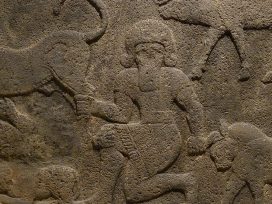As a child I once bathed in the Danube. It was on a mild spring evening in 1967. I’d come to Budapest from a town where there was no water far and wide – neither still nor flowing. Not even a puddle. On top of that, in the middle of the Hungarian plain I’d never even seen a hill, let alone a mountain. No water, not a mountain. So when I jumped into the water in northern Budapest with a view of the not so distant mountains, I was almost beside myself with joy. Like someone who has opened the door onto a new and unimagined world.
What seemed to me then as a huge novelty turned out to be anything but that. My experience might have been new, but as I swam around in the Danube I was overcome by almost atavistic sensations. Moreover, that northern part of Budapest where I experienced the Danube for the first time is called “Romans’ beach” – after the Romans who used to live here and who, through the ruins, are present to this day. They also built the first bridges over the Danube, for example at Aquincum in the north of Budapest, near to Romans’ beach, whose foundations, built with wooden stakes, were surveyed in the second half of the nineteenth century. It was as if I was submerged in a kind of common past. Unconsciously, I was experiencing the same thing as millions and millions of others before me. On that evening in May 1967 I still knew nothing about the Danube, had no idea about its history, about the blossoming cultures along its banks, didn’t know the fantasies, ideas, hopes entwined around it. But my senses refused to be tricked. They knew very well that I wasn’t bathing only in the Danube, but also in the myth of the Danube. That was also perhaps why I took such pleasure in the powerfully surging river. I was submerged in a myth. “Now and forever”: that could be the motto of all water. Especially of rivers, which are eternally changing, assuming new forms, whose drops find themselves in permanent exchange – although from its source to its estuary the river is a single, constant whole.
Back then of course, in 1967, such thoughts didn’t pass through my mind; I simply enjoyed plunging into the fast moving, powerfully surging current. It was only after I’d lived by the Danube for several decades that I understood why one has such thoughts particularly when looking at rivers – though of course it doesn’t do any harm if the river is also big and powerful. In around 170 BC the Roman emperor Marcus Aurelius wrote the following words, albeit not at Romans’ beach in Budapest but in Carnuntum, east of Vienna: “So remember these two points: first, that each thing is of like form from everlasting and comes round again in its cycle, and that it signifies not whether a man shall look upon the same things for a hundred years or two hundred, or for an infinity of time; second, that the longest lived and the shortest lived man, when they come to die, lose one and the same thing.” I’m convinced that the sight of the Danube helped Marcus Aurelius attain these insights. After all, in the summer of 1936, almost two millennia later, it inspired similar thoughts in the great European poet of the century, Attilia József, who was born in Budapest and grew up in Hungary. By his time the banks of the Danube in Budapest hadn’t been sandy for ages; by the end of the nineteenth century the water had already been coerced between elegant stone walls. But even the modern quays, which were able to tame the physical strength of the water, couldn’t eradicate the archaic, ancient character of the river.
Attila József’s poem “By the Danube” begins with the words: “As I sat on the bottom step of the wharf / A melon-rind flowed by with the current; / Wrapped in my fate I hardly heard the chatter / Of the surface, while the deep was silent.” The juxtaposition of permanence and transience is varied a few lines later: “[a]nd the sprightly waves / In playful gaiety laughed at me again, / Like a child on his prolific mother’s knee, / While other thoughts were racing through her brain. / They trembled in Time’s flow and in its wake, / Like in a graveyard tottering tomb-stones shake.” But at the end of the poem the opposition between life and death is dissolved in all-encompassing time: “In the Danube’s waves past, present and future / Are all-embracing in a soft caress.” (Trans. from the Hungarian by John Szekely.) Looking at the Danube, Attila József experiences something similar to Marcus Aurelius: there’s something inherent to this river that relativizes the antithesis between surface and depth, transience and permanence, life and death. The Danube: a seemingly unheeding, deeply natural force. And yet it offers deeply human insights to all those who listen to its message and understand it. As William Wordsworth put it in his sonnet “The source of the Danube” (1820), it inspires the imagination (“fancy”), which follows its “track of silver light” from its innocent, infant source to the terrifying Black Sea. And Hölderlin, in his poem “At the source of the Danube”, written in 1801, professed in connection with the same river: “She comes to us / As a stranger, the awakener, / The human-forming voice.” The Danube gives the inhabitants of its banks their humanity – by bestowing upon them insights that enable them to exceed the narrow seeming limits of the human.
A paradoxical river.
*
But let’s leave the mythical and return to the everyday.
What colour is the Danube?
“Once you have heard the rushing of river, abandon forever forging plans for the future.” These words were written by the Hungarian author Gyula Krúdy in his Dream Diary, which appeared in 1925, precisely a quarter century after Sigmund Freud’s Interpretation of Dreams. Not happy lines for the Danube basin, whose countries at the time had the First World War behind them, without suspecting that an even greater evil lay before them. It connects South and North, East and West, but also day and night, dream and waking. It flows through very different cultures, connects opposites, yet never subsumes them. The Danube, whose source for many centuries was just as mysterious as that of the Nile in Egypt, was never able to form the realm into a truly single entity – and yet it remained the sole and exceptional river for the residents of Ulm or Passau just as for those of Vienna, Budapest, Novi Sad and Nikopol, not to mention Braila or Sulina. It connected peoples and regions that seem irreconcilable. Perhaps only in dreams or poetry could they have been brought together. Maybe one explanation for why it was here, by the Danube, that two important books about dreams were written. A river, then, whose course somewhat resembles psychoanalysis, which not coincidentally was discovered on the banks of the Danube and reveals unexpected layers of the soul.
“Happy is he who forgets what cannot be altered.” These words are all too familiar to us all: joy and melancholy exude from the lines of Johann Strauss’s Die Fledermaus, which was first performed near to where we are now, in the Theatre by the Wien, on 5 April 1874. One can sense the longing for the carefree suppression of memory, but also sadness about the inexorability of fate. These lines also arose on the banks of the Danube – the Danube that, in his waltz composed a few years earlier in 1866, the same Johann Strauss called blue (The Blue Danube). Spellbound by the sweet Danube, he wrote another waltz twenty-two years later, this time with the title Danube Maidens. It was based on a familiar legend about a merman king and his daughter. They all lived in the depths of the Danube in a castle made of blue-green crystal. The mermaids were indescribably beautiful and the earthly young men that caught a glimpse of them were forever devoted to them. One of the mermaids, the Danube Maiden, warned a young man and his father one winter about an impending storm, thus saving all the people who lived on the banks of the river. However the young man was unable to save himself: the following spring, enchanted by the Danube Maiden’s beauty, he went out into the river in the hope of seeing her again. The next morning his empty canoe was found. The Danube Maiden Fountain, inspired by the legend, was unveiled in the city park of Vienna in 1865, followed a little later by the aforementioned waltz. The Danube Maiden had two faces, like the river itself: picturesque on the one hand, dangerous on the other. As it did for the German poet Heinrich von Kleist after the battle of Aspern on 21 and 22 May 1809. His friend and regimental comrade, the military writer Rühle von Lilienstein, later recalled that the Austrians would have been defeated by Napoleon at Aspern on the Danube, “had the ripping current unfortunately not torn apart the bridges before half of his army had crossed over to the Lobau.” (Unfortunately, wrote Rühle, because he later fought on the side of the French.) Thus the Austrians were victorious, and Kleist wrote the next day a short couplet entitled “The Rescue of the Germans”: “The Gods had all deserted us, but the Danube Maiden / had mercy on us, and I confer upon her Mars’s temple.” And how did Kleist know this Danube Maiden, which in the form of a flood destroyed the French pontoons, though it was only during the battle that he first set eyes on the Danube? He’d learned about her from the quill of the Austrian dramatist Karl Friedrich Hensler, whose romantic-comical musical The Danube Maiden premiered in Vienna in 1799 and was staged in Dresden in 1802. Hensler’s play was the inspiration for Ludwig Tieck dramatic fragment The Danube Maid (1808), and also had an impact on Kleist’s fantasy.
The Danube maid is seductive: she is beautiful, while also being equipped with the weapons of Mars. (A few days before the Battle of Aspern, the French marshal Lannes tripped and fell into the Danube; his friend Napoleon immediately jumped into the water and saved the marshal, who was later fatally wounded in the battle.) Her beauty makes the Danube a blue river, however she is also foreboding. Like a picture by Egon Schiele that bears the title “City on the Blue River”, but whose subtitle is “Dead city”; in it, the painter allows the muddy yellow, the grey and even the black to shimmer through the blue of the Danube. For Strauss this river is blue, for Schiele black; after the battle of Aspern, Heinrich von Kleist probably found it red. And some find it muddy yellow, others steely grey. Does it even have a colour? A single colour, I mean?
No. If I again ask the question, “What colour is the Danube?” what comes to my mind is a palette of colours, in which alongside blue there also appear gloomy, dark, even foreboding colours and tones.
Because I’m from Budapest, what occurs to me for example is the muddy yellow colour that predominated during the catastrophic floods which struck Pest on 13 March 1838; even today countess small marble plaques on Pest walls recall this flood. The deluge, which made a deep impact on the collective Hungarian memory, was also the harbinger of the other great, political deluges of 1848, the revolution that began with the arrival of the latest political news from Vienna – news which of course came via the Danube, on a boat. This revolution, although defeated, was also the start of the subsequent development of the middle class in Hungary – an exceedingly contradictory process that repeatedly had recourse to the symbol of the calm yet dangerous Danube. It is no coincidence than it was in Hungary that the first stable bridge over the Danube – Chain Bridge – was inaugurated in 1849 as a symbol of the modernization process. Yet by the time the second bridge – Margaret Bridge – was inaugurated in 1873, the residents of Pest and Buda were plagued with worry. This inspired the great Hungarian poet János Arany to write his ballad “Consecration of the Bridge”. For him, Margaret Bridge was a symbolic construction: it opened not only the route from East to West, bit also the route from life into death. If I think of the Danube in Budapest, the term “dance of death” comes to mind. Why? Because in this poem the bridge is swarming with suicides – victims of modern society that cannot find a way out.
The development of the middle class was always a paradoxical process in most countries of the Danube basin. Hungary too. Two years after János Arany’s poem was written, Alfréd Hajós (1875-1955) was born, an important Hungarian architect of the twentieth century. Among his buildings is the Hungarian National Swimming Stadium, which still stands today on the most beautiful of all the islands on Danube, the Margaret Island. It was 1930. Hájos was originally called Guttmann; like the majority of important contemporary Hungarian architects he was of Jewish origin and, like his fellows in fate, did a great deal towards giving Budapest a modern architectural face in keeping with the times. Both the Swimming Stadium and Leopoldstadt, a new city district on the Pest bank of the Danube opposite the island, are influenced by the spirit of the Bauhaus. Between the wars, the residents of Leopoldstadt were predominantly Jewish, and today it is still the most homogenous looking part of Budapest. When I look at the Swimming Stadium on the Margaret Island or the buildings of Leopoldstadt on the quay on the Pest side of the river, it’s not only the modernization process that comes to my mind, but inevitably also the emergency of autumn 1944 and winter 1945, when the Danube became a theatre of horror for Budapest’s Jewish population. Not only did this sector of the population do the maximum for the civil development of Hungary, it also suffered the greatest.
At the beginning of the nineteenth century, the English poet William Bake described in his prophetic poem “Jerusalem” the impending apocalypse with the following words: “The Rhine was red with human blood, / The Danube rolled a purple tide; / On the Euphrates Satan stood / And over Asia stretched his pride.” As far as the Danube was concerned, Blake’s prophecy was borne out; at the beginning of 1945, as one survivor remembered it, the Danube “wasn’t blue, wasn’t brown, the Danube was red, from the blood of the Jews”. When the Arrow Cross took over on 16 October 1944, they indiscriminately rounded up the Jews and drove a part of them to the banks of the Danube, where they shot them en masse, so that the dead fell into the river. The river carried away the first body on 23 November, and after that hundreds upon hundreds of new victims; around 3600 people were shot into the river over the course of the winter. Just over a dozen survived the execution; those who were shot into the water but managed to reach the shore alive were given the nickname “Danubers” by the inventive Budapesters. The Danube proved to be destructive and life-saving at the same time. As the Hungarian writer István Örkény put it, in winter 1944 Budapest was a “bloodbath city”.
But this bloodbath on the Danube wasn’t the first. Two years previously, in January 1942, Hungarian units carried out a mass murder upon the civilian population in the region of Novi Sad: 3340 people, predominantly of Serbian and Jewish origin, were shot down, most of them ending up in the icy waters of the Danube.
Budapest’s magnificent bridges also suffered the war. During World War Two, the Germans first blew up Margaret Bridge (4 November 1944) and then, in January 1945, Franz-Josef Bridge, Chain Bridge and Elisabeth Bridge. This signalled the end of a fateful chapter of Hungarian history. The Danube was once more uncrossable – thus symbolically pre-empting the barbed wire put down shortly afterwards that was to make the passage between east and west impossible.
There is, however, another bridge that ought to be mentioned in this context: the Nibelungen Bridge in Linz. It was dreamed up by Hitler, who grew up nearby and whose intention it was to develop Linz into a metropole. The first step was to build the bridge, over which the first traffic crossed in 1940. The monumental urban architecture, which even in the designs appears terrifying, was prevented by war from being completed; had it been realized, not only would the Danube have been violated, its colour would have been changed to brown for ever. The spectre of the brown Danube also haunts us nowadays, by the way: one of the most disgusting websites on the Internet is the Austrian neo-Nazi site called “Alpen-Donau”, whose server is located in the US.
*
Allow me once again to refer to János Arany’s poem “Consecration of the Bridge”. In the poem the bridge is crowded with suicides. It doesn’t lead from one bank of the Danube to the other, but becomes in effect a cul-de-sac. A paradox that has its roots deep in the history of the Danube. After all, the Danube was always a boundary, a limes, and whoever dared to overstep it always had to reckon with danger. Even the Romans conquered only the western part, Pannonia – and Diocletian organized his empire on the western bank of the Danube. The Danube was the boundary that shielded the southern and western civilizations against the East and the North. The Danube thus became a dividing line between civilization and barbarism, between radiant reason and unbridled instincts. For the first Hungarians it was the bridge between Christianity and paganism – let’s not forget that bishop Gellert, the missionary from Venice, was thrown into the Danube by the pagans from the cliffs of what is today Gellért hill. And as late as 1817, the German writer Achim von Arnim referred to the Danube in his novel The Crown Watchmen as a river that contains “the arch enemy of Christendom, the Turks”.
It is precisely because it is also a limit that the Danube fills the Hungarians not only with pride but also with fear. This river is like a wound, wrote Sándor Petöfi in the fourth decade of the nineteenth century, comparing it with a broken heart: “How often oh Danube are you split and stirred / by the raging storm and the ship’s course! // And as mighty long and deep the wound does gape, / so your heart beats not with passion.”
What is the origin of this sense of woundedness? Perhaps because the Danube is impossible to conquer. This mighty river has no consistent visage. It comes from afar – from the Black Forest, where, as a stream, it is perhaps still blue, and dies far away, in the Balkans, in the Black Sea, where it is impossible to see from one bank to another, and where all waters are said to be black. In order to master the Danube, in other words to feel at home on the banks of the Danube, you have to be able to balance between west and east, south and north, blue and black, between past and future. To again cite Attila Jószef’s poem “By the Danube”: “In the Danube’s waves past, present and future / Are all-embracing in a soft caress.”
This is the English translation of the speech László F. Földényi delivered at the opening of the Literatur im Herbst literary festival 2011, Vienna, 28-30 October






